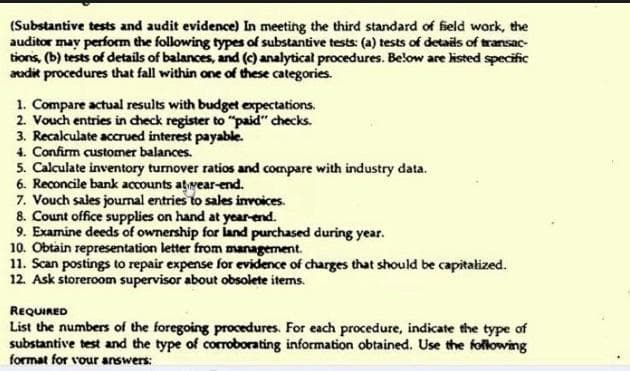(Substantive tests and audit evidence) In meeting the third standard of field work, the auditor may perform the following types of substantive tests: (a) tests of details of transac- tions, (b) tests of details of balances, and (c) analytical procedures. Below are listed specific audit procedures that fall within one of these categories. 1. Compare actual results with budget expectations. 2. Vouch entries in check register to "paid" checks. 3. Recalculate accrued interest payable. 4. Confirm customer balances. 5. Calculate inventory turnover ratios and compare with industry data. 6. Reconcile bank accounts at year-end. 7. Vouch sales journal entries to sales invoices. 8. Count office supplies on hand at year-end. 9. Examine deeds of ownership for land purchased during year. 10. Obtain representation letter from management. 11. Scan postings to repair expense for evidence of charges that should be capitalized. 12. Ask storeroom supervisor about obsolete items. REQUIRED List the numbers of the foregoing procedures. For each procedure, indicate the type of substantive test and the type of corroborating information obtained. Use the following format for your answers:
(Substantive tests and audit evidence) In meeting the third standard of field work, the auditor may perform the following types of substantive tests: (a) tests of details of transac- tions, (b) tests of details of balances, and (c) analytical procedures. Below are listed specific audit procedures that fall within one of these categories. 1. Compare actual results with budget expectations. 2. Vouch entries in check register to "paid" checks. 3. Recalculate accrued interest payable. 4. Confirm customer balances. 5. Calculate inventory turnover ratios and compare with industry data. 6. Reconcile bank accounts at year-end. 7. Vouch sales journal entries to sales invoices. 8. Count office supplies on hand at year-end. 9. Examine deeds of ownership for land purchased during year. 10. Obtain representation letter from management. 11. Scan postings to repair expense for evidence of charges that should be capitalized. 12. Ask storeroom supervisor about obsolete items. REQUIRED List the numbers of the foregoing procedures. For each procedure, indicate the type of substantive test and the type of corroborating information obtained. Use the following format for your answers:
Auditing: A Risk Based-Approach (MindTap Course List)
11th Edition
ISBN:9781337619455
Author:Karla M Johnstone, Audrey A. Gramling, Larry E. Rittenberg
Publisher:Karla M Johnstone, Audrey A. Gramling, Larry E. Rittenberg
Chapter11: Auditing Inventory, Goods And Services, And Accounts Payable: The Acquisition And Payment Cycle
Section: Chapter Questions
Problem 35RQSC
Related questions
Question

Transcribed Image Text:(Substantive tests and audit evidence) In meeting the third standard of field work, the
auditor may perform the following types of substantive tests: (a) tests of details of transac-
tions, (b) tests of details of balances, and (c) analytical procedures. Below are kisted specific
audit procedures that fall within one of these categories.
1. Compare actual results with budget expectations.
2. Vouch entries in check register to "paid" checks.
3. Recalculate accrued interest payable.
4. Confirm customer balances.
5. Calculate inventory turnover ratios and compare with industry data.
6. Reconcile bank accounts ativear-end.
7. Vouch sales journal entries to sales invoices.
8. Count office supplies on hand at year-end.
9. Examine deeds of ownership for land purchased during year.
10. Obtain representation letter from management.
11. Scan postings to repair expense for evidence of charges that should be capitałized.
12. Ask storeroom supervisor about obsolete items.
REQUIRED
List the numbers of the foregoing procedures. For each procedure, indicate the type of
substantive test and the type of corroborating information obtained. Use the following
format for vour answers:
Expert Solution
This question has been solved!
Explore an expertly crafted, step-by-step solution for a thorough understanding of key concepts.
Step by step
Solved in 2 steps with 1 images

Knowledge Booster
Learn more about
Need a deep-dive on the concept behind this application? Look no further. Learn more about this topic, accounting and related others by exploring similar questions and additional content below.Recommended textbooks for you

Auditing: A Risk Based-Approach (MindTap Course L…
Accounting
ISBN:
9781337619455
Author:
Karla M Johnstone, Audrey A. Gramling, Larry E. Rittenberg
Publisher:
Cengage Learning

Accounting Information Systems
Accounting
ISBN:
9781337619202
Author:
Hall, James A.
Publisher:
Cengage Learning,

Auditing: A Risk Based-Approach to Conducting a Q…
Accounting
ISBN:
9781305080577
Author:
Karla M Johnstone, Audrey A. Gramling, Larry E. Rittenberg
Publisher:
South-Western College Pub

Auditing: A Risk Based-Approach (MindTap Course L…
Accounting
ISBN:
9781337619455
Author:
Karla M Johnstone, Audrey A. Gramling, Larry E. Rittenberg
Publisher:
Cengage Learning

Accounting Information Systems
Accounting
ISBN:
9781337619202
Author:
Hall, James A.
Publisher:
Cengage Learning,

Auditing: A Risk Based-Approach to Conducting a Q…
Accounting
ISBN:
9781305080577
Author:
Karla M Johnstone, Audrey A. Gramling, Larry E. Rittenberg
Publisher:
South-Western College Pub